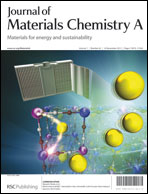Carbyne polysulfide as a novel cathode material for lithium/sulfur batteries
Abstract
A novel organic sulfide named carbyne polysulfide was prepared by co-heating carbyne analogue and elemental sulfur. The carbyne analogue was obtained by dehydrochlorination of polyvinylidene chloride. By means of several characterization methods, it was proved that the carbyne polysulfide has a unique and stable structure of a conducting sp2 hybrid carbon skeleton connected to energy-storing sulfur side chains. And in terms of morphology, it has a well-developed porous structure with an uneven pore size. The elements C and S in the organic sulfide are approximately 43.4 wt% and 54.1 wt% respectively. As a cathode material for lithium/sulfur batteries, the carbyne polysulfide displays a high reversible capacity of 960 mA h gsulfur−1 after 200 cycles at 0.1 C (168 mA gsulfur−1) current rate in carbonic ester electrolyte. It also exhibits a reversible capacity as high as 705 mAh gsulfur−1 when cycled at 1 C (1680 mA gsulfur−1) current rate. This organic sulfide exhibits great potential as a promising cathode material for high performance rechargeable lithium/sulfur batteries.


 Please wait while we load your content...
Please wait while we load your content...